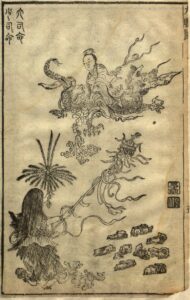The Legacy of Chinese Shamanism: The Wu and Their Successors

Shamanka from ‘Leaving Sorrow’ chapter of The Songs of Chu
As my project on shamanism, fuelled by a plethora of ahistorical misinformation, draws to a close, only two artices are left to be finalized:
On their spirit journeys across vast spaces, through the clouds and skies, the god and shaman rejoice in movement for its own sake, an endless flow without purpose. ‘Mistress of the Xiang’ concludes with a yearning ‘to roam and ramble’ with the goddess, for time is short. ‘‘The Earl of the River’ (hebo河伯) begins:
Together with you I’ll roam – the Nine Rivers.
The shaman then describes ‘Ascending Mount Kunlun’, the world axis, but only for the touristic exhilaration (‘My heart flew up’) of ‘looking in all four directions’. This is very different to the spirit journey of the classic shaman, who goes off in search of spirits who can assist with a cure, or for souls that have gone astray, an itinerary with a set and adamantine purpose. In the ‘Nine Songs’, the journey seems to aim not at a point or goal, but towards infinity itself:
Seizing the reins – I soar again on lifted wing,
Journey off – east into boundless heaven.
So there is a hint of what is more than a mere tourism, a philosophical or metaphysical travel. This is not only what travel means at the level of the absolute, the free wanderings of the divinity, but as the romantic union of human and deity, it is also the journey appropriate to love.
The ‘Nine Songs’ are thus an early example, perhaps even a (secondarily) shamanic origin, of the classic Chinese poem of travel through grand and visionary spaces, and the similar wanderings of the Daoist Immortal through mountainous regions and across the stars, as explored by Livia Kohn and Isabelle Robinet. If ‘Leaving Sorrow’ converted the spirit travel of the ‘Nine Songs’ into a Ruist-shamanic hybrid, then one of the Han Dynasty poems of The Songs of the Chu, ‘Far Roaming’ (yuanyou 遠遊), in turn converted ‘Leaving Sorrow’ into a Daoist epic of spirit journeying, eventually passing beyond the world of topographical forms into the formless purity of the origin. In soteriological mysticism, the spirit journey is a vertical ascent through planes of existence or consciousness that draw progressively closer to the absolute. But for the Daoist, there is also space for a horizontal roaming without purpose, a relishing of the multiplicity, ceaseless change, and particularity of the celestial as well as earthly manifestations of the dao or ‘way’.
-Mark Offord, ‘Wandering Far and Unfettered’: The Wu as ‘Secondary Shamans’ in The Legacy of Chinese Shamanism
Cover Art: Jen King
Would you like to subscribe to our newsletter?
If you enjoyed reading this please consider supporting us!
When we started the Purple Cloud Institute, our aim was to make accessible educational material about traditional Chinese cultural practices. We strive to keep prices of our books as affordable as possible and the content we provide free of charge. However, there are many ongoing behind the scenes costs and the time taken to provide such content is considerable.
If you have enjoyed our offerings please consider donating and supporting us. The help will allow us to make time to bring you more in the way of book publications, podcasts and videos about tradition-based Daoist, Chinese medicine and martial arts and help keep these traditions alive.
Your assistance is greatly appreciated!
